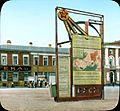Five-year plans for the national economy of the Soviet Union facts for kids
The five-year plans were a series of big economic plans in the Soviet Union. They started in the late 1920s. These plans aimed to quickly develop the country's economy. The government decided what would be produced and how. They set goals for factories and farms across the entire nation.
Contents
What Were the Five-Year Plans?
The Soviet Union was a country that existed from 1922 to 1991. Its government wanted to change the country from a farming society into a powerful industrial one. To do this, they created a series of "five-year plans." Each plan set specific goals for the economy over a five-year period.
Why Did They Use These Plans?
The main goal was to make the Soviet Union strong and modern. Leaders like Joseph Stalin believed that central planning was the best way. They wanted to quickly build up heavy industries. This included making steel, machinery, and electricity. They also wanted to improve farming.
How Did the Plans Work?
The government controlled almost everything. They decided how many goods would be made. They also decided where factories would be built. Workers were told where to work. Farmers were often forced to join large collective farms. The plans set very high targets for production.
Key Goals and Outcomes
The first five-year plan began in 1928. It focused heavily on industry. New factories were built. Many people moved from farms to cities to work in these factories.
Industrial Growth
The plans led to a rapid increase in industrial production. The Soviet Union built many new mines, power plants, and factories. They became a major producer of steel and coal. This quick growth came at a high cost.
Challenges and Hardships
Life was very difficult for many people. Working conditions were often harsh. There were shortages of food and consumer goods. People had to work long hours. The government used strong methods to make sure targets were met.
Impact on Society
The five-year plans changed Soviet society a lot. Cities grew rapidly. More people got an education, especially in technical fields. However, individual freedoms were limited. The government controlled what people could do and where they could live.
Agriculture Under the Plans
Farming was also changed by the plans. The government forced farmers to give up their small plots of land. They had to join large state-controlled farms called collectives. This was known as collectivization. Many farmers did not want to join. This led to widespread resistance and severe food shortages.
Long-Term Effects
The five-year plans helped the Soviet Union become an industrial power. This strength was important during World War II. However, the plans also caused great suffering. They led to a centralized economy. This meant the government made all economic decisions. This system lasted until the Soviet Union broke apart in 1991.
Images for kids
-
Large notice board with slogans about the 5-Year Plan in Moscow, Soviet Union (c., 1931) by a traveler DeCou, Branson. It reads it's made by a state-run paper «Economics and Life» (Russian: Экономика и жизнь)
See also
 In Spanish: Plan Quinquenal (Unión Soviética) para niños
In Spanish: Plan Quinquenal (Unión Soviética) para niños


